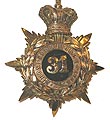 The East Surrey Regiment
The East Surrey Regiment 
The American War of Independence 1775-1783
French War 1793-1815
The American War of Independence, 1775-1783
Both the 31st and the 70th were to serve in the War in North America. In 1776, the 31st were sent to Canada and took up defensive positions along the St Lawrence River to protect the recently captured province of Quebec from the American insurgents. Early in 1777, General Burgoyne, whose force was augmented by the flank companies of the 31st, was ordered to Albany, some 250 miles to the south, there to unite with General Howe’s Army advancing from the south. Unfortunately, the latter had not been properly informed of Burgoyne’s advance, and consequently did not go forward to meet the Army from the north. The luckless Burgoyne fought his way down the Hudson River, against heavy odds, but finally outnumbered by four to one, was forced to surrender with 4,000 men at Saratoga on 14th October 1777.
In May 1778, the 70th were ordered to North America where the battalion companies were assigned to garrison duties in Nova Scotia. The flank companies, that is, the Grenadier and Light Companies, were detached and sent to join General Clinton’s army in New York, some 600 miles to the south. These flank companies were soon in action in various operations ranging from New York to Charleston, a further 600 miles to the south. The flank companies returned to New York before the surrender of Lord Cornwallis’s army at Yorktown in October 1781, but it was not until 1783 that the 70th returned to England.
Regimental County Titles
In 1782, nearly all Regiments of Foot (The Queen’s were an exception) were given county titles, although they retained their numbers to indicate precedence. The 31st became the Huntingdonshire Regiment, and the 70th, later to become the 2nd Bn The East Surrey Regiment, became the Surrey Regiment. A Depot Company of the 70th was then established at Kingston-upon-Thames to recruit men of the county of Surrey for that Regiment. Although the 70th had never been officially designated a Scottish regiment, they also took the subsidiary title of The Glasgow Lowland Regiment from 1812 to 1825. It is believed this attempt to acquire a Scottish title was attributable to certain Scottish officers in the 70th, but it is recorded that in 1825 ‘Due to various objections, the Regiment’s own wish was approved, and the county title of 70th (Surrey) Regiment was restored’.

The 31st Regiment in the French Wars, 1793-1815
When war against the French broke out, the flank companies were detached from the main body of the 31st Regiment, as had occurred in the war in North America some 16 years previously, and were sent to the West Indies in the winter of 1793. During the next year they took part in the capture of Martinique, St Lucia and Guadeloupe, though the last named island was recovered by the French in December 1794. The flank companies of the 31st had 21/2 years in the West Indies before they rejoined the Regiment at St Lucia in May 1796.
Here the enemies were the French and native insurgents, and above all, the ever-present yellow fever which took its grim toll of the Regiment. In 1796 alone, the 31st lost 17 officers and 870 men, and when it sailed for home in the summer of 1797, the Regiment mustered a mere 85 soldiers.
Two years at home and drafts of reinforcements restored the Regiment to full strength before embarking for Holland in 1799. The principal operations were the attacks on Bergen and Egmont op Zee in October, but all British forces were back in England by the end of the year. It was not long, however, before the 31st were embarked for further operations. After various ineffectual landings in the Mediterranean, the Regiment disembarked to garrison Minorca where it remained until May 1802. The Treaty of Amiens, which then ended the War of the French Revolution, was no more than a truce, and the war against Napoleonic France was renewed in 1803.
In May 1802 the 31st left Minorca for home; and two years later were ordered to raise a 2nd Battalion to counter the Napoleonic threat. The 1st/31st were then sent back to the Mediterranean, where, based in Sicily, they served from 1806 to 1815. The principal operations during this period were the unsuccessful attack on Rosetta, where they suffered 221 casualties, and the capture of Genoa from the French.
The history of the 2nd Battalion is described in the Peninsular War section, after the story of the 70th in the Napoleonic War.
Related
